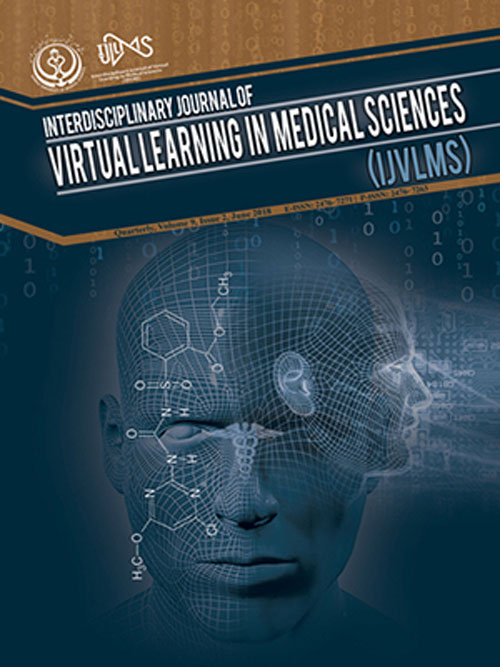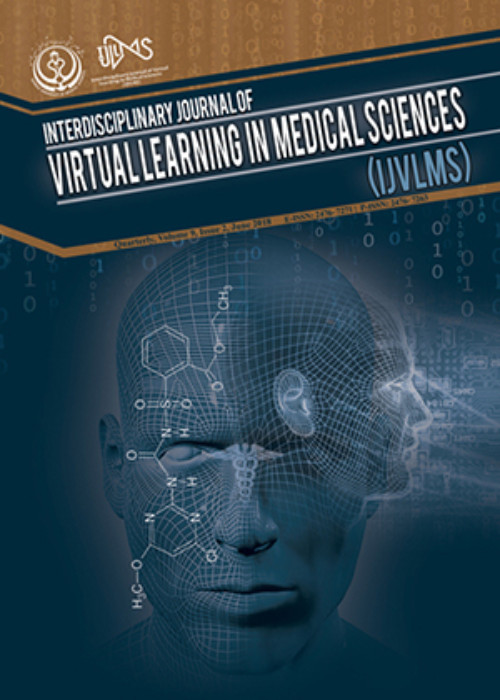فهرست مطالب

Interdisciplinary Journal of Virtual Learning in Medical Sciences
Volume:10 Issue: 4, Dec 2019
- تاریخ انتشار: 1398/09/10
- تعداد عناوین: 8
-
-
Pages 1-13BackgroundHigher education is considered as a source of inspiration and a major factor in the development and advancement of every society. The realization of an effective education in any educational institution requires the formation of an efficient teaching-learning process. The purpose of this study was to design a framework for mobile learning in higher education.MethodsIt is an analytical-oriented qualitative study in designing a framework-based meta-synthesis. Data were collected through documentary method using search engines as well as valid websites presenting national and international articles. In the search for mobile learning keywords in higher education, 418 Persian and English papers were found and after examining their titles, it appeared that the majority of them covered topics relevant to mobile learning, such as e-learning. Hence, a total of 119 articles were selected to consider their abstracts. Upon studying the abstracts and contents of the above-mentioned articles, 71 papers were chosen. Due to the principles of conducting meta-synthesis research and omitting incomplete papers, 52 articles were selected for content analysis.ResultsAccording to the results, five main dimensions including: strategy, data, process, infrastructure and human forces are recognized for adopting mobile learning in higher education. Infrastructures develop the highest frequency in the considered studies and out of 52 papers only 42 of them have mentioned codes and factors relevant to the infrastructure.ConclusionExperts in this study provided their assessments and opinions about research findings in order to score, acknowledge and finalize the dimensions of m-learning in higher education.Keywords: Designing, Mobile Learning, Mata-Synthesis Approach, Higher Education
-
Pages 14-27BackgroundStudies have shown that there is a gap between theory and practice in the use of learning analytics in educational settings. Some researchers attribute this gap to not taking learning theories into consideration in the use of learning analytics in educational contexts. This study was conducted to address the role of learning theory in applying learning analytics in educational contexts.MethodsThis is a qualitative study and the study design is content analysis. Thematic analysis was used as the research method. Data for this study was collected through an interview with 14 experts in the fields of learning analytics and learning theory who were selected purposefully. Theoretical saturation method was used to determine the sample size. Content analysis techniques were used to analyze data and content validity index (CVI) and Cohen’s kappa coefficient were performed to measure the validity and reliability of the findings.ResultsData analysis was performed to identify three main roles for learning theory in learning analytics including underpinning role, guiding role, and sense-making role.ConclusionThe results suggest that first, learning theory should underlie learning analytics (where to begin). Second, application of learning analytics in educational settings should be guided by learning theory (what and how to do), and third, learning analytics’ reports should be interpreted based on the learning theory implications for education (answer to question why).Keywords: Learning Theory, Learning Analytics, Thematic Analysis
-
Pages 28-39BackgroundHumans have always needed to store and retrieve information. In the last decades, one of the most important phenomena in the information industry was the emergence and popularity of machine reader databases, especially online databases. The main purpose of this study was to design and validate a model for databases in open and distance universities.MethodsThis research is a descriptive study conducted by survey method. The statistical population of the present study consists of all specialists in the field of studying databases and open and distance educational universities. In a small part, sampling was done by a census method and in a purposeful manner. The responses were analyzed using descriptive and inferential statistics and by SPSS and Lisrel software. For the purpose of examining the parametric deflections, the Kolmogorov–Smirnov test was used to check the normality of the data. The Levene’s test was used to examine the default of variances and obtain the inferential part of factor analysis. The current research was carried out in 2 qualitative and quantitative phases. In the qualitative phase, some of the distance education scholars and database experts were selected as a purposive sample to analyze the basic parameters obtained in the first phase. In the quantitative phase, sampling was done through census and purposive manner from professors’ at the University of Isfahan (N=211). 22 questionnaires were excluded due to reasons such as non-functional responses, and statisctical analysis was carried out for 189 participants. To measure content validity index (CVI), Waltz and Bausell index was utilized and the instrument under investigation was presented to 8 experts who were engaged in the content validity stage.ResultsThe results of the research showed that databases in open and distance universities in Iran have high quality and quantity regarding the search and search features and the technical aspects.ConclusionBased on this research a major issue of concern is to find a framework and model which can be used by executives and managers from distant backgrounds to evaluate the quality of their existing databases.Keywords: Distance Learning, Open Education, Databases, Evaluation
-
Pages 40-53BackgroundOnline learning environment (OLE) has provided teachers with excellent opportunities for professional development. The present study attempted to investigate how Iranian teachers used this for their professional development.MethodsIn this study qualitative research approach was used. The participants consist of 25 teachers who actively promote the educational applications of the virtual environment. They were selected from among the teachers of Hamedan Province and were invited to a semi-structured interview. Snowball sampling technique was used, and the number of participants was decided to be 25 according to the principle of theoretical saturation.ResultsThe findings suggested that teachers mostly use information retrieval, production and presentation of contents, and interactive tools for their professional development. By using information retrieval tools, they can access their required information in various fields, become informed about conferences and educational workshops, rethink their experience as well as improve their selfconfidence in responding to students’ questions. By using content production and presentation tools, they can produce high-quality multimedia contents, design various learning activities, encourage students to participate in activities, and adopt active teaching methods.Conclusionteachers can use online learning environment (OLE) for their self-directed professional development through searching, interactive and content production tools.Keywords: Teacher's Professional Development, Virtual Environment, Phenomenology, Curriculum Implementation
-
Pages 54-64BackgroundThe aim of this study was to assess the level of e-learning readiness among the faculty members in Iranian universities.MethodsThis is a survey research and the statistical population included all faculty members of 23 selected Iranian universities in March-September 2018. The population of the study included about 750 professors selected through simple random sampling. The instrument of study was a questionnaire titled “Evaluation of Instructors’ Readiness for E-learning in Iranian Universities”. Its content and face validity were verified by professionals, and its reliability was measured through Cronbach’s Coefficient alpha which was (0.72-0.86). To analyze the data, descriptive and mean, SD statistics (independent T-test) were used.ResultsThe average e-readiness score of professors from the 23 selected universities amounted to approximately 4.3 out of 10, which is indicative of a relatively “weak” e-readiness status. Also, the score of over 60% of the criteria was “less than average”.ConclusionGiven the decreasing numbers of e-learning students in Iran, the results of this study show that one of the important reasons for the failure in the development of universities’ e-learning systems can be the lack of e-learning readiness among instructors.Keywords: E-Learning, E-learning Readiness Assessment, Faculty Members, Higher Education, Iranian Universities
-
Pages 65-74BackgroundPersonality traits and the perception of chief background factors, are largely influenced by educational systems. Therefore, the present study believes that a collective understanding of a particular context leads to the creation of a culture that forms the basis of entrepreneurial activities.ObjectivesExamining the mediating role of blended learning infrastructures in the relationships between social capital, good governance and the general perception of business environment among the owners of small and medium sized enterprises in Fars province, Iran.MethodsThis is an applied research, and in terms of data collection it is a descriptive-correlation analysis of variance based on path analysis. For data gathering, stratified sampling was applied to select 366 samples among 3887 active small and medium-sized enterprises in Fars province.ResultsGood governance has a direct effect (P=0.736, sig.<0.001) as well as an indirect effect (P=0.059, sig.<0.001) on the perceived business environment through the blended learning infrastructures. Also, the direct effect of social capital on the perceived business environment (P=0.041, sig.=0.315) was not confirmed, but its indirect effect through blended learning infrastructures was confirmed (P=0.305, sig.=0.03).ConclusionsBefore reinforcing the blended learning infrastructures, one needs to initially strengthen the macro political and economic factors, followed by social, cultural and educational factors, in order to improve the perceived business environment and create a positive attitude towards this atmosphere. This is due to the fact that governmental infrastructures are not yet as developed as much as the educational infrastructures for developing entrepreneurship.Keywords: Social capital, Good governance, Perceived business environment, blended learning infrastructures


